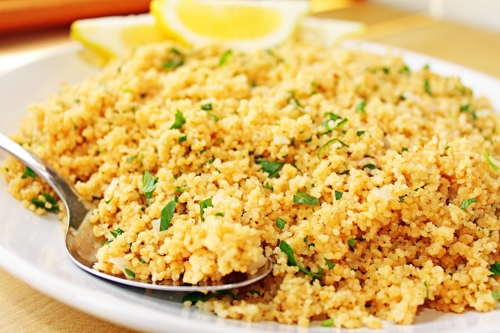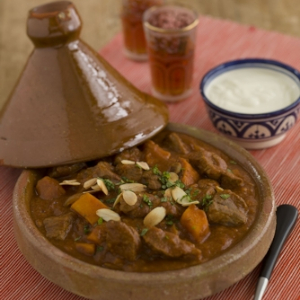After taking sister Erin’s sage advice and doing a three-parter on the cuisine of Japan, I’ve been bugged to do some others. First on the list is Morocco, whose food traditions are unlike any other on the face of the earth, much less in North Africa. Come away with me and sample the bounty!
 Classic Couscous: A micro-pasta you can use anywhere you’d normally
Classic Couscous: A micro-pasta you can use anywhere you’d normally
use orzo, small pasta like orecchietti, or rice. Great for stuffings!
This time, I’ve chosen venerable food knowledge source The Spruce Eats.com as the anchor for my rundown of select, classic Moroccan dishes ‘we should all try before we die’. (As the big-time headline writers always say; except that I could never see how we could, or why we’d want to try, any food – no matter how delightful – after we’d died. Anyway…)
Along the way, I’ll be adding a couple or three suggestions from my own experience, just because they’re iconic, and really, really good!
Our menu for today…
(See below for some special notes on Moroccan ingredients.)
Couscous is a tiny-grained pasta product often mistaken for pale yellow rice by first-time diners. Like Angel Hair pasta and Ramen noodles, it cooks in the blink of an eye when you pour boiling water over it, because its cross-section is so small. According to The Spruce Eats, “Couscous is prepared weekly in many Moroccan homes. […] lamb, beef, or chicken is stewed along with a variety of vegetables, then arranged on a glorious heap of tender, steamed couscous grains. As with many other Moroccan dishes, everyone gathers round to eat from one super-sized communal plate.
Tagine is both the name of what may be the most famous Moroccan cooking method and the vessel it’s prepared in. All Tagines are stews of some sort or other, heavy on the veggies and fruits, and the variety is endless. “[Ingrdients, cut in large pieces,] are arranged in conical fashion and left undisturbed to cook until tender, making a delicious, beautiful presentation. Tagines are traditionally eaten directly from the cooking vessel, using pieces of Moroccan bread (khobz) to scoop up meat, veggies, and sauce. For a vegetarian version, simply omit the meat (you’ll need to reduce liquids and cooking time) or try a veggie-only tagine.
Bastilla: “Chicken Bastilla is Morocco’s famous rendition of a savory pie, and it simply doesn’t get better than this. Traditionally, pigeons were the birds of choice, but here chicken is cooked with saffron, ginger, pepper, and cinnamon, then layered within crispy warqa pastry with an herb-laden omelet and fried almonds scented with orange flower water. An utterly amazing fusion of flavors and textures.”
Chicken with Lemons and Olives, “is also one of Morocco’s most famous and ubiquitous dishes. And no wonder. It’s utterly delicious and works beautifully for any occasion ranging from casual family dinners to celebratory banquets. You’ll find it offered in homes, restaurants, and even on the street in tiny outdoor dining venues. Shown (at the link, above) is a roasted chicken with preserved lemons and olives presentation, but the dish is also easily prepared in a traditional tagine or conventional pot. Lots of onions are cooked to a puree-like consistency with saffron and ginger; preserved lemons and olives are tangy additions to finish the dish.
Lamb or Beef with Prunes
Even if you don’t normally reach for prunes when grocery shopping, don’t be put off by this particular combination of sweet and savory. Your palate will be well rewarded for venturing into new Moroccan territory with this lamb or beef with prunes recipe. The meat is cooked until buttery tender with saffron, ginger, and onions, then topped with prunes that have been poached in syrup with cinnamon and honey. Crunchy fried almonds serve as a garnish. Still not convinced? Then maybe you’d rather try another classic Moroccan dried fruit tagine, chicken with apricots.
Harira
You’ll find all kinds of soups served in Moroccan homes and restaurants, but this one stands out from the crowd for being uniquely Moroccan and very much loved throughout the country. Variations are countless, but typically harira is a tomato-based soup laden with lentils and chickpeas. Rice or fine broken noodles (chaariya) are often added as well, while the stock is usually made with beef or lamb. This authentic harira recipe does not fall into the quick and easy category, but the effort to make it won’t disappoint.
Sardines and other Seafood
Sardines are the traditional every-day fish served in Morocco, and they can – and are – prepared in just about every way you can imagine. Plentiful and easy to catch in the waters off the country’s rich and extensive coast, they’re enjoyed throughout the nation. Other fish and seafoods are not as available as Sardines and are typically not served every day like Sardines; they’re served only on special occasions. “You can keep things ultra simple and simply bake or grill whole sardines, but one of the most popular ways to prepare them is to stuff sardine fillets with a zesty marinade called chermoula and then fry them. It’s a treat not to miss, whether as a sandwich filler or as an entreé set out alongside other fish and seafood for a Moroccan fried fish dinner. (Please note: We’re talking the fresh, 6 in. / 15 cm – 8 in. / 20 cm fish, here; not the ones that come canned and preserved in oil or brine.)
Moroccan ingredients
There are some Morrocan ingredients that are not not found in any other cuisines, an a few that are found elsewhere, but take on special prominence in Morocco:
Ras al hanout is a ‘propietary’ Moroccan spice blend that is considered a trademark flavour of that country’s cuisine. Like Curry in India or Chili Powder in the U.S. southwest, it’s found in almost everything in its homeland.
Harissa is piquant paste is as old as its culture and there are as many recipes for it as there are cooks who love it. The main ingredients are roasted Sweet Red and Hot Red peppers, skins and seeds removed, caramelized Onions (to taste), Garlic, Coriander, Cumin, Olive Oil and Lemon Juice. You may like the version favoured in some regions which includes Caraway or Fennel. These are all simmered together until all components are soft, then mashed in a mortar and pestle into a thick, smooth paste. Of course, you can use a blender or a food processor to make your paste.
Onions are found in many Tagines and most other Moroccan stews. If you’re planning to cook Moroccan, always have some on hand; just assume you’ll need some.
Dried fruits are also fairly common in Moroccan recipes. Always have Dried Prunes and apricots on hand if you’re going to make a Tagine or other Moroccan recipe.
Lentils and Chickpeas are quite common in every-day Moroccan cooking. They’re also staples in other styles of Mediterranean cooking. And if you have some on hand at all times, you’ll find yourself trying them in other dishes, as well.
My take
I’ve personally eaten, at one time or another, the Lamb with Prunes, the Chicken with Preserved Lemons and Olives, and the Harira Soup. I thought all were amazing! And, as my kitchen habits and preferences ebb and flow, I’ve used couscous a lot over the years. Try it anywhere you’d normally use Orzo, small pasta like orecchietti, or Rice. Great for stuffings!
~ Maggie J.

